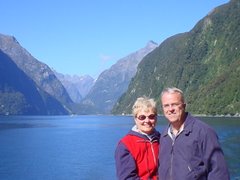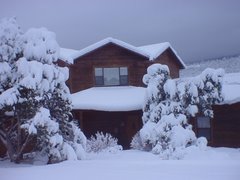Since we've been in Vegas this month, I've been looking for an opportunity to go back out there, not to spend a night, just to see the sights and feel the awe. Susie was not interested in making the trip.
Yesterday, Saturday, was the day. Forecast all week had been for a very cool weekend and that's how it turned out. Low 70s for a high in Vegas, mid-80s in Death Valley. Perfect. I went to baseball game Friday night and nearly froze (UNM beat TCU). Very windy, also. I left at sunrise Saturday and got to the Furnace Creek Visitor Center in DV a couple of hours later. Here are a couple of pictures along the road entering the park from the east.
I didn't have much of an agenda, but after watching video and talking to Park Rangers I decided to visit Scotty's Castle. I thought it might be a little like the Bishop Castle we visited last summer in Colorado - an eccentric one-man project. Well, it was, but in a very different way.
Scotty (Walter Scott) was not a grizzled prospector with a burro and a pick axe who got lucky, as you might expect. He was a con man who got lucky. He found a victim who became a co-conspirator.
The Castle is an hour's drive north of Furnace Creek, through the valley lined with rugged mountains on both sides.
I spent about 45 minutes exploring the grounds, then took a guided tour of the very nice home, a millionaire's retreat, but not really a castle (though called such by Scotty as part of his scam). The reason this part of Death Valley was selected is there is a spring in what is called Grapevine Canyon, on the east side of the valley, that runs year-around with good water at a rate of 200 gallons per minute. With that you can power an electricity generator and have all the water you need for consumption, plumbing, and amenities like a swimming pool.
Here are some pictures of the castle and the grounds.
I guess it's this tower, actually used to store water, that gives it the castle appearance.
I've never seen such shaggy palm trees. Several, here, are clustered around a cottonwood tree.
Some old cars and trucks:
Here's our tour guide, a ranger dressed to depict a Castle visitor in the late 1930s.
I'll go mostly with his story.
Walter Scott was a rider in the Buffalo Bill Wild West Show in the late 1800s. That was his start in show business. Some years later he worked in Colorado gold mines, from which he picked up a couple of gold nuggets. He had previously been in Death Valley and knew it to be active with prospectors seeking gold and silver (and 20 mule-team borax, but that's another story). With his nuggets and gift of gab he went back east, telling stories about his fabulous gold find in Death Valley and seeking investors whose funds would enable him to develop the mine and make everybody fabulously wealthy. People bought in, including Albert Johnson, an insurance company executive from Chicago.
Johnson and others soon realized that there was no payoff for their investments in "Death Valley Scotty's" gold mine. Scotty lived the life of a wealthy gold mine owner, so he apparently he spent investor funds on himself and didn't even make some Ponzi-like payments to early investors along the way. Johnson and some other investors decided to visit Death Valley and inspect their mine. Scotty said, Come on out. En route, as their party crossed a pass into the valley, they were attacked by outlaws. Shots rang out. Scotty's brother, part of the party, was hit. Scotty (according to our guide) hollered out, "Hey, stop shooting. You weren't supposed to hit anyone." And the attackers stopped. The fake attack had been designed by Scotty to scare the investors away so they wouldn't find that there was no gold mine.
You would think Scotty would end up disgraced and in jail. Wrong. What happened was that Scotty became great friends with Johnson and his wife, Bess. The Johnsons fell in love with Death Valley, visited often, and started buying land in Grapevine canyon. They liked the peace and quiet, the clean air, the warmth in winter; it was good for their health. They decided to build a retreat that, at Bess's instigation, became the elaborate mission-style home you see above. Construction began in 1922.
Scotty was part of the effort - in fact, he was the front man. He created the impression that this was his Castle, built with the proceeds from his gold mines and in fact was built over one mine's entrance. He told visitors who wondered who this other couple on site were that they were his banker and his (the banker's) wife, just visiting. The Johnsons were happy to be part of this charade. It let them have the peace and quiet they desired and it provided a stage for their friend, Scotty. They even paid Scotty a $250/mo. stipend. In later years, Johnson was asked how he could be so generous with someone who had taken so much of his money. He said, "He more than repaid us with laughter."
Here's the Castle's main room. After dinner, Scotty would tell the guests his Wild West stories. At some point Johnson would signal one of the servants. Other servants in the house's basement would start pounding on the basement walls and ceiling. Scotty would get upset and say, I've told those miners to be quiet and not work when guests were around." Thus, the myth about the gold mine under the house was perpetuated.
At the end of the evening, Scotty would retire to an adjacent room, "his bedroom." But, it was fake. He would exit a back door and go to his cabin a couple of miles down the canyon. Scotty seldom, if ever, spent a night in "his Castle."
One other bit of tomfoolery. There was a hole in the alleged-bedroom wall. On the outside, the hole was covered by a piece of curved metal designed to be a deflector. Scotty's story was that this was part of his security system. If thieves ever tried to break in and steal his gold he would thrust his shotgun into this hole and fire. The deflector would direct some of the pellets to the right and disable anyone trying to come in through a window and simultaneously the other pellets would turn left and disable attackers at the door. Our guide said there's no evidence that this theory was ever tested.
The stock market crash of 1929 kept the Johnson's from finishing their plans for Scotty's Castle. For a time, they rented out rooms to visitors. The nicest suite rented for the equivalent of around $500/night in today's dollars.
I asked our guide how it was that Scotty could keep up his scam and how the truth finally came out. Among the visitors were newspaper reporters. He said there was a lawsuit around 1939 that exposed the fraud. I haven't found whether there a conviction or jail time - but apparently not. Johnson willed the Castle and ranch to a religious organization with the proviso that Scott could live there, which he did until his death in 1954. The organization sold the property to the National Park Service in 1970.
I've given you maybe more than anybody ever wanted to know, fact and fiction, about Death Valley Scotty and his Castle, but if anybody has more info, please post it or email me.
Some philosophy. To some, maybe many, their interest in a place like Death Valley is nature at its purest. So, they would not be interested in and maybe even offended by structures that impose on nature, such as Scotty's Castle. But, I'm intrigued by man's interaction with nature in such extremes: dramatic dams, bridges, roads, buildings, ... can actually make you more aware of and appreciative of nature's wonders, I think. In a more mundane situation, I enjoy the view outside our living room which is a mountainside dotted with a few houses, and I don't think the view would be more interesting if those houses weren't there. But, that's just me.
On the way back to Furnace Creek I saw a coyote crossing the road and stopped and got this picture.
He didn't look as well-fed as our Cedar Crest coyotes.
On down the road I stopped at the ruins of a borax processing plant and a friendly fellow tourist and I took each others picture in front of the large wagons used to haul the borax.
From there I drove on south through the park. One stop is Badwater, the lowest point in the Park at 282 ft. below sea level.
There was more dramatic scenery along the way, salt flats and mountains.
Here, on the way back to Pahrump, is what I think is a typical Nevada range and basin scene.
We saw a lot of it a couple of years ago when we drove US 50 across Nevada, the Loneliest Highway.
I stopped in Pahrump for gas and espied, across the road, "the world's tallest ice cream stand." I'm always drawn by statistical extremes (I bought a Death Valley t-shirt: Hottest, 134 degs, Driest, less than 2 in.rain per year, Lowest, 282 ft. below sea level), not to mention ice cream, so I made a visit there. Pineapple sundae, my high school favorite. (I didn't ask the friendly server for proof for their claim.)
(Mike says grandson Jason has this familial interest in extremes, so Mike keeps the Death Valley weather page on his cell-phone.)
Got back to Vegas in time to go to the final game of the Mountain West Conference baseball tournament which UNM won 22-3 over San Diego State. The Lobos advance to an NCAA regional tournament this week. Go Lobos!
Tuesday is Twins Day.
We'll be in touch.
Rob and Susie
























No comments:
Post a Comment